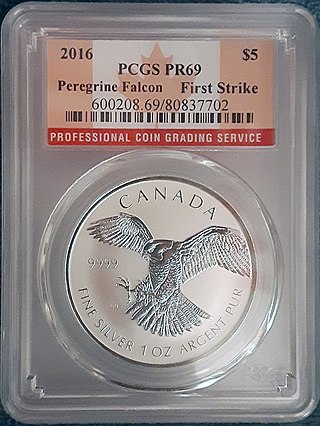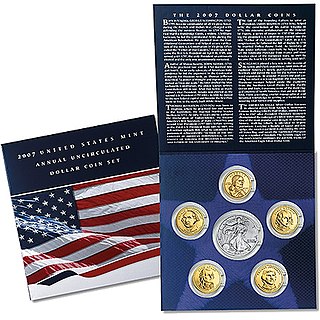
The dollar coin is a United States coin with a face value of one United States dollar. Dollar coins have been minted in the United States in gold, silver, and base metal versions. Dollar coins were first minted in the United States in 1794.

Coin grading is the process of determining the grade or condition of a coin, one of the key factors in determining its collectible value. A coin's grade is generally determined by six criteria: strike, preservation, luster, color, attractiveness, and occasionally the country/state in which it was minted. Several grading systems have been developed. Certification services professionally grade coins for tiered fees.

The Eisenhower dollar is a one-dollar coin issued by the United States Mint from 1971 to 1978; it was the first coin of that denomination issued by the Mint since the Peace dollar series ended in 1935. The coin depicts President Dwight D. Eisenhower on the obverse, and a stylized image honoring the 1969 Apollo 11 Moon mission on the reverse. Both sides were designed by Frank Gasparro, with the reverse based on the mission patch designed by astronaut Michael Collins. It is the only large-size U.S. dollar coin whose circulation strikes contained no silver.

The Canadian fifty-cent coin is a Canadian coin worth 50 cents. The coin's reverse depicts the coat of arms of Canada. At the opening ceremonies for the Ottawa branch of the Royal Mint, held on January 2, 1908, Governor General Earl Grey struck the Dominion of Canada's first domestically produced coin. It was a silver fifty-cent coin bearing the effigy of King Edward VII.

The American Silver Eagle is the official silver bullion coin of the United States. It was first released by the United States Mint on November 24, 1986, and portrays the Goddess of Liberty in a design by Adolph A. Weinman that was originally used on the Walking Liberty half dollar from 1916 to 1947.

The Peace dollar is a United States dollar coin minted for circulation from 1921 to 1928 and 1934 to 1935, and beginning again for collectors in 2021. Designed by Anthony de Francisci, the coin was the result of a competition to find designs emblematic of peace. Its obverse represents the head and neck of the Goddess of Liberty in profile, and the reverse depicts a bald eagle at rest clutching an olive branch, with the legend "Peace". It was the last United States dollar coin to be struck for circulation in silver.

The Morgan dollar is a United States dollar coin minted from 1878 to 1904, in 1921, and beginning again in 2021 as a collectible. It was the first standard silver dollar minted since the passage of the Coinage Act of 1873, which ended the free coining of silver and the production of the previous design, the Seated Liberty dollar. It contained 412.5 Troy grains of 90% pure silver. The coin is named after its designer, United States Mint Assistant Engraver George T. Morgan. The obverse depicts a profile portrait representing Liberty, modeled by Anna Willess Williams, while the reverse depicts an eagle with wings outstretched. The mint mark, if present, appears on the reverse above between D and O in "Dollar".
Numismatic Guaranty Company (NGC) is an international third-party coin grading and certification service based in Sarasota, Florida. It has certified more than 60 million coins. NGC certification consists of authentication, grading, attribution, and encapsulation in clear plastic holders. NGC is a subsidiary of Certified Collectibles Group (CCG), which owns six collectible certification services and is in turn owned by Blackstone, a multibillion-dollar New York City hedge fund.

A key date is a term used in coin collecting and it refers to a date of a given coin series or coin set that is harder to obtain than other dates in the series. A key date coin is usually one with a lower mintage total and it is more valuable than others in the series. Many coin collectors collect coins to fill out a complete set of a series.

The 1792 half disme is an American silver coin with a face value of five cents which was minted in 1792. Although it is subject to debate as to whether this was intended to be circulating coinage or instead an experimental issue, President George Washington referred to it as "a small beginning" and many of the coins eventually were released into circulation. It is widely considered the first United States coinage struck under authority of the Coinage Act of 1792.
First strike is a marketing term used by third party coin grading services which refers to coins which were struck first by a mint. The U.S. Mint maintains that there is no widely accepted and standardized numismatic industry definition of First Strike coins. Several coin grading companies have decided that a "first strike" coin is one that shipped from the mint in the first month of the new minting.
Third-party grading (TPG) refers to coin grading & banknote grading authentication, attribution, and encapsulation by independent certification services.

The America the Beautiful quarters were a series of fifty-six 25-cent pieces (quarters) issued by the United States Mint, which began in 2010 and lasted until 2021. The obverse (front) of all the coins depicts George Washington in a modified version of the portrait used for the original 1932 Washington quarter. There were five new reverse (back) designs each year, each commemorating a national natural or historic site such as national parks, national historic sites, or national forests – one from each state, the federal district, and each territory. The program was authorized by the America's Beautiful National Parks Quarter Dollar Coin Act of 2008 (Pub. L. 110–456 .

The 1-yen coin is the smallest denomination of the Japanese yen currency. Historically they were initially made of both silver and gold in the early 1870s. Issues facing the Japanese government at the time included wanting to adopt the gold standard, and competing against the Mexican dollar for use in foreign trade. The decision was made to use silver one yen coins exclusively outside of Japan for trade, while gold coins were minted and used in mainland Japan. Gold and silver coins were eventually allowed to co-circulate in mainland Japan from 1878 to 1897 when they were demonetized. Millions of former one yen silver coins were countermarked by the Japanese government for use outside of the mainland. Silver one yen coins continued to be minted until 1914 for backing up currency.
The America the Beautiful silver bullion coins comprise a series of silver bullion coins with a face value of a quarter dollar. The coins contain five troy ounces of silver, making them the largest silver bullion coins ever issued by the United States Mint. The design of the coins duplicates exactly—though enlarged—each of the America the Beautiful quarters. They were issued from 2010 to 2021. The coins were available for sale during the year in which their corresponding circulating coin is issued. The coins are distributed by the United States Mint's network of authorized bullion dealers, and may be resold at the discretion of the Director of the National Park Service.

The Sheldon Coin Grading Scale is a 70-point coin grading scale used in the numismatic assessment of a coin's quality. The American Numismatic Association based its Official ANA Grading Standards in large part on the Sheldon scale. The scale was created by William Herbert Sheldon.

A coin set, or mint set, is a collection of uncirculated or proof coins, released by a mint. Such sets are usually released annually and often called a year set. They include sets of all the circulating coins of that year, as well as sets of commemorative coins.
The one rin coin (一厘銅貨) was a Japanese coin worth one one-thousandth of a Japanese yen, as 10 rin equalled 1 sen, and 100 sen equaled 1 yen. The coins are no longer in circulation, but they are bought and sold both by professional numismatists and by amateur coin collectors.

Coin slab is a type of holder for a coin. Slabbed coins are typically from one of the coin grading companies. The practice of sending coins to third-party grading companies and then "slabbing" them began in 1986.















